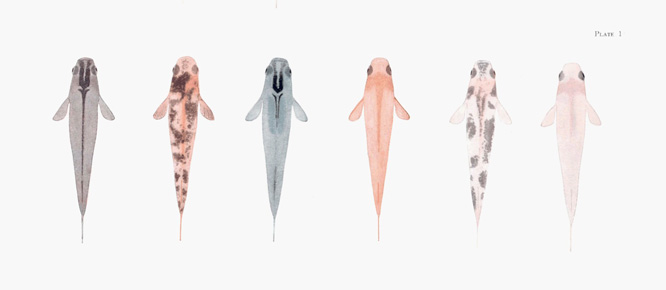Since the 17th century, the tiny medaka fish that dart through rice paddies in Japan have been bred as living ornaments. Though in the wild they are a nondescript mud color, medaka occasionally turn up in flashier mutant varieties — orange-red, pearlescent white, black splotched — that were much prized by generations of fish fanciers. Around 1913, medaka color varieties caught the attention of zoologist Tatuo Aida.
Aida was interested in a hot new field that was beginning to be called “genetics.” On the heels of emerging reports that medaka color traits followed Mendelian laws of inheritance, Aida started breeding the fish at his Kyoto home. He filled the garden with a network of canals to supply freshwater to his medaka nursery, and while World War I raged, he meticulously mated fish and recorded the colors of their offspring.
The results, published in 1921 in GENETICS, revealed that medaka had an XY sex determination system and that a gene linked to orange coloration was carried on the Y chromosome (one of the first examples of Y-linked inheritance). Most significantly, Aida demonstrated that the X and Y chromosomes could exchange genetic material via crossover, contrary to results from the best known XY system at the time, Drosophila.
Fast-forward nearly a century, and a Genetic Toolbox Review in the April issue of GENETICS reveals how far medaka research has come since Aida published the fruits of his home-grown experiments.

Left: Mutant strain lacking pigmentation, allowing visualization of internal organs in adults; Center: In vivo analysis of medaka embryo somites differentially labeled with the Gaudí brainbow toolkit; Right: In vivo imaging of neuronal GFP expression from a brain-specific enhancer. Autofluorescent pigment cells are red. All images from Kirchmaier et al.
Aida laid the groundwork for generations of Japanese medaka geneticists, along with physiologists, embryologists, and ecotoxicologists. During the last few decades, biologists outside Japan have taken increasing advantage of the model’s experimental benefits, including its small genome, ready access to wild stocks, and a high tolerance of inbreeding. The ease of generating inbred lines makes medaka an important complement to the widely used zebrafish model, which can be maintained only as polymorphic lab stocks. An international collaboration of researchers is now constructing a panel of more than 200 inbred lines sourced from a single wild population, which will serve as a powerful resource for high resolution genetic mapping of complex traits.
Much of the genetic technology developed for zebrafish has also been adapted for medaka. Today’s researchers can look up a gene in the medaka reference genome, manipulate it with the new genome editing tools TALENs, zinc finger nucleases, or CRISPR, light up individual cells with brainbow labeling technology, and perform live-imaging of adult fish in transparent mutants. Such tools are helping an international research community explore important questions in genomics, evolution, and human disease, just over a century since Aida began investigating the mysteries of heredity from his Kyoto garden.

Tatuo Aida in his garden, photographed by the late Toki-o Yamamoto, another pioneering medaka researcher. Photo courtesy of Kiyoshi Naruse, who received it as a gift from Tokihiko Yamamoto.
CITATIONS:
Aida, T. (1921). On the inheritance of color in a fresh-water fish, Aplocheilus latipes Temmick and Schlegel, with special reference to sex-linked inheritance.
Genetics, 6(6), 554 http://www.genetics.org/content/6/6/554
Kirchmaier, S., Naruse, K., Wittbrodt, J., & Loosli, F. (2015). The Genomic and Genetic Toolbox of the Teleost Medaka (Oryzias latipes).
Genetics, 199(4), 905-918
doi:10.1534/genetics.114.173849 http://www.genetics.org/content/199/4/905.full
Spivakov, M., Auer, T. O., Peravali, R., Dunham, I., Dolle, D., Fujiyama, A., Toyoda, A., Aizu, T., Minakuchi, Y., Loosli, F., Naruse, K., Birney, E., & Wittbrodt, J. (2014). Genomic and phenotypic characterization of a wild medaka population: towards the establishment of an isogenic population genetic resource in fish.
G3: Genes| Genomes| Genetics, 4(3), 433-445
doi:10.1534/g3.113.008722 http://www.g3journal.org/content/4/3/433.full































